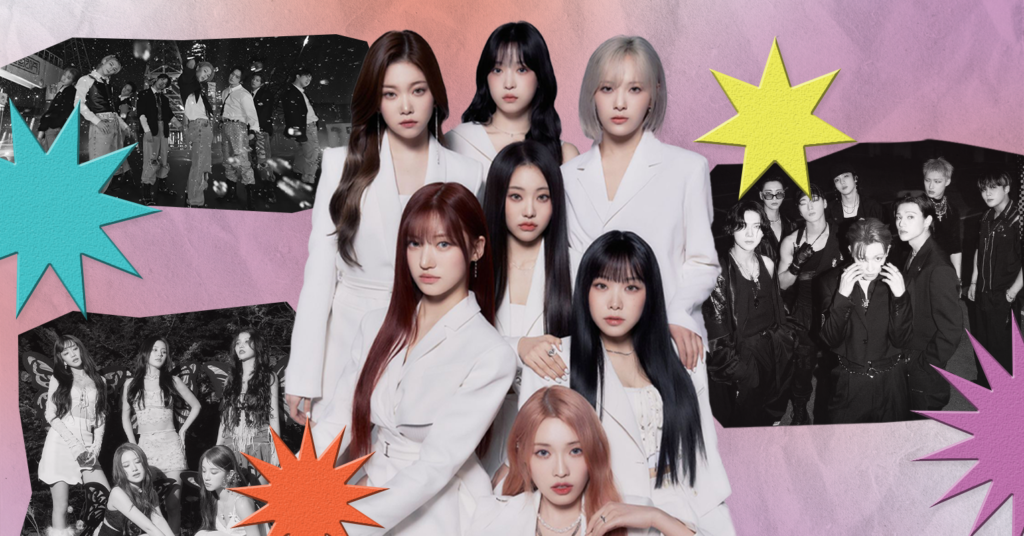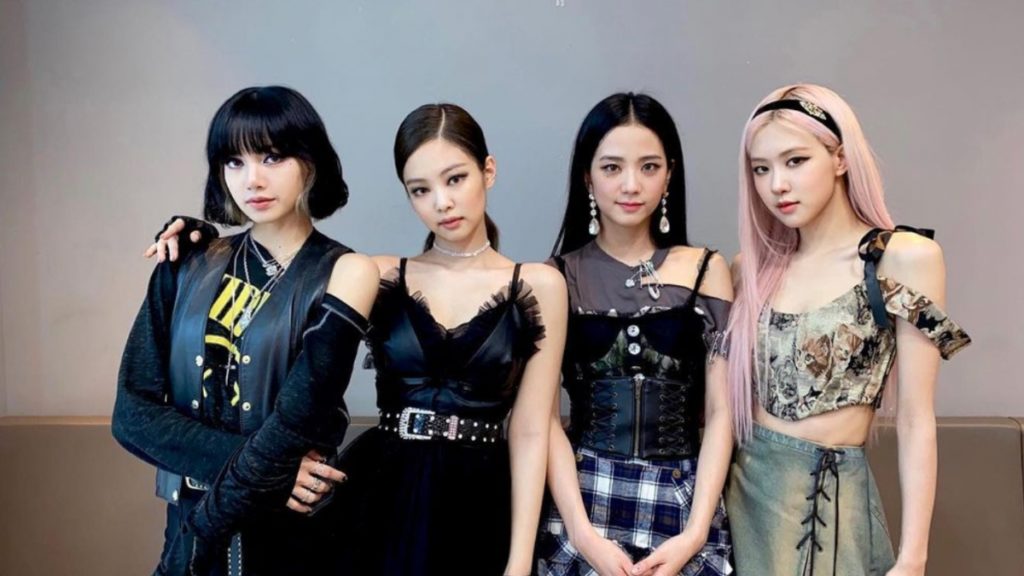The Z Wave: How Fourth-Gen K-pop Is Changing the Game

K-pop has increased in popularity in the past couple of years, with the genre becoming known in more than just niche fan circles. A study by the Statista Research Department in 2021 showed that in over 18 countries, 39% of respondents reported that K-pop was becoming “very popular in their country.” But what has made the genre so popular? The same study reported people find it easy to enjoy K-pop because of the catchy choruses, but those familiar with it know it’s deeper than that. What K-pop was, compared to what it is nowadays, is completely different. How has the genre maintained its growing popularity despite the changes in the industry? The answer is adaptability. K-pop has exploded in the past 10 years, and the people carrying the industry on their backs are members of Generation Z. EnVi is here to break down how the Gen Z-led fourth generation of K-pop and their fans have transformed the industry.
The Rise of K-pop
The charm of K-pop is that it is unlike the typical Western music industry formula – an album, random music videos, and a slew of merchandise pumped out for the album cycle. K-pop often features intense choreography, encourages fan interaction, and tends to tell a story. Groups, such as SM Entertainment’s H.O.T and S.E.S., were some of the first trailblazing K-pop acts as they rose to stardom. They, along with many other groups, laid the framework for what would eventually be the blueprint for K-pop as an industry.
H.O.T. (High Five of Teenagers), largely considered the world’s first K-pop boy group, debuted in 1996. H.O.T. created their image based on the idea that they would sing about society and teenage angst. At the time of their debut, there was yet to be a group like them – characterized by an idea and sticking to it. Paired with their looks, charm, and talent – H.O.T. took South Korea by storm. All of their full albums sold close to or over one million copies. Meanwhile, S.E.S – standing for the members’ names Sea, Eugene, & Shoo – expanded on H.O.T’s idea and gave it a feminine twist. The girl group became popular quickly, beginning their career with cute love songs like “I’m Your Girl,” and “Dreams Come True.” However, the group garnered more attention as their concepts grew edgier. Because S.E.S did not stick to just one image, they explored any concept they wanted. S.E.S’s push towards more mature concepts opened the door for more female K-pop acts today.
Although groups like H.O.T. and S.E.S. were popular, their reach at the time was mainly in East Asia. The first generation of K-pop created the foundation, but it would be years, several generations, and a few viral hits before the genre exploded to global heights.
Enter the rise of Gen Z.
Looking for Gen Z’s Attention
Generation Z consists of those who were born from 1997 to 2012. Being raised in an age with ever-changing technology, Gen Z has never known the world without the Internet. With the World Wide Web being synonymous with “home, sweet home” for Gen Z, marketing tactics took a massive shift to appeal to the younger generation.
Rather than solely relying on live performances and music videos like previous K-pop generations, the industry has taken to utilizing other mediums such as Instagram, TikTok, and Twitter with dance challenges featuring other idols for cross-promotion. Superlabel HYBE’s indie label, ADOR, posted a uniquely animated promotional calendar for their superstar rookie girl group, NewJeans, capturing the attention of those who saw the visual spectacle. But a shift in marketing tactics does not easily sway the pragmatic and financially minded Gen Z, which has led to album packaging and design changes as well.
As part of her master’s thesis explaining K-pop albums in the digital age, university student and researcher Wibecka Oliver explained, “…albums have a consistent thematic packaging style that is attractive to consumers. The textures and visual material, including portraiture, provide a sensorial experience that is an important frame for the music.” The push for more physical album sales, especially when appealing to Gen Z, who are financially conscious, has resulted in intricate packaging designs, unique inclusions, and exclusive photocards of the artists.
K-pop has seen some of the most distinctive album packaging since the fourth generation’s emergence. From fragrance-infused pouches within NCT DOJAEJUNG’s first EP, Perfume, to ciphers hidden on various cards throughout ATEEZ’s TREASURE album series to NewJeans’ trendy debut album and purse duo, these are just a few of the enthralling packages that have made albums so much more than a plastic case with a CD. Just as Oliver stated, these albums were specifically designed to enhance the consumer’s experience with the sensation of unboxing a themed album. NCT DOJAEJUNG’s boxed set was marketed as a luxury fragrance kit, meanwhile, ATEEZ’s TREASURE series left clues for their fans to find their own treasure alongside the pirate-themed group the album packaging, and NewJeans ushered in the resurgence of the Y2K aesthetic with their smaller purses and affinity for ‘00s pop influences.
Arguably, had it not been for their supporting packaging for the albums, the concepts associated with these fourth-generation groups would not have been nearly as prominent. But album packaging and new marketing strategies barely scrape the surface of the mass changes seen within the K-pop industry today.
Let’s Talk Lore
With the rise of fourth-generation K-pop—artists that debuted between 2017 and 2023—lore and storytelling have become key factors for many groups, such as ATEEZ, Billlie, and CIX. Take your pick of any genre, from action to fantasy to mystery and more, there’s an abundance of thrilling stories within K-pop today. Storytelling is no longer bound to one song, music video, or even album, and inspiration for these concepts spans from astronomy theories to 14th-century literature. This detailed and innovative take on storytelling from K-pop groups has fans waiting for updates, just like a television or movie series.
ATEEZ has carried themselves as self-proclaimed pirates with their debut tracks, “Pirate King” and “Treasure.” Over four years later, the group continues to expand on this story with their album-exclusive diary entries, songs, performance stages, and even the themes of their tours. With a narrative of breaking the status quo and defying a controlling government, the members navigate themselves and their fans through an anarchist movement. With the power of music, dance, and their own emotions, ATEEZ are on a mission to overthrow those in power and give people the choice of free will in this time-traveling rebellion.
Billlie is an example of another fourth-generation group that focuses on bringing stories to life through their content. Prior to their debut in late 2021, short-film-style videos set the scene for the mystifying tale that is continuously being unfolded by the group. Their lore begins with a heavy emphasis on the number 11 and the mysterious disappearance of an unknown character, and friend of the girls, known as Billlie Love. However, the question arises if Billlie Love is truly a real person or perhaps a representation of something else within the girls.
Boy group CIX, the “concept kings” according to their fans, have a concept that is closely connected to Dante’s Poem Trilogy: The Divine Comedy. While entertainment companies don’t expect fans to recognize these allusions at first, these concepts encourage fans to make connections themselves and interpret the story. Fans even take it upon themselves to make videos and social media threads to help explain the concept to those who need help figuring it out.
Elevating Standards
The latest generation of K-pop artists has elevated the performance standards set by their senior colleagues. They’ve gone above and beyond when pushing the envelope on gender norms, live stages, and artist involvement in songwriting and production.
(G)I-DLE has positioned themselves as the ultimate girl-crush girl group, reminiscent of groups who came before them like 4MINUTE and 2NE1. With songs like “TOMBOY” and “Nxde” they have pushed back on gender norms and what is expected from women idols in the industry today. They have found a way to speak to Gen Z’s universal need to express their individuality and desire to not be boxed in.
Boy group ONEUS has taken live performance up a notch by incorporating traditional Korean elements within their stages. They often use cultural instruments, outfits, and dances, such as the fan dance, drum dance, and martial arts-inspired movements, in their choreography. ONEUS draws inspiration from historical periods and folktales, embracing traditional clothing like hanboks and instruments such as the janggu (hourglass-shaped drum) and gayageum (a traditional string instrument) in their music. It serves as a way to not only honor their roots but to also teach their larger global audience about Korean culture.
Most notably, this era marks the start of groups producing their own music and openly talking about the process. With albums-worth of accredited works registered with the Korea Music Copyright Association, Stray Kids’ leader Bang Chan has been involved in the process from the start, producing most of the group’s music since their debut. It isn’t new for members of K-pop artists to write their songs, but the fourth generation has set a precedent for groups to become more involved in the process right from the start of their careers.
Gen Z’s Influence
Due to Gen Z’s influence on the music trends and market, their enjoyment of an album or song could make or break its success. Veteran K-pop group, SHINee, released the track, “Don’t Call Me” from their seventh album in spring 2021. The song was a stark step away from the more bright and funky sound they were known for but blended in seamlessly with the gritty sound of fourth-generation K-pop that appeals to Gen Z. While many dedicated fans of the group, Shawols, eagerly anticipated SHINee’s comeback and supported the song with ease — the track pulled in newer and younger fans to the group.
Additionally, the rise of TikTok memes and trends has helped elevate the profiles of K-pop stars, music, dramas, and more. Most recently, rookie girl group FIFTY-FIFTY has seen incredible feats with their song “Cupid” due to TikTok. One user decided to speed up the song and use it as background music for a contradicting video that took off within the app. The popularity of the trend and using the track has resulted in it placing in the Top 20 of the Billboard Hot 100, over 300 million streams on Spotify, and the group signing with U.S. record label, Warner Music.
K-pop as a whole has enjoyed massive success worldwide, and it is largely due to the expansive work done by the latest generations of the genre. With imaginative marketing techniques, intense choreographies, increased fan interaction, and direct roles in music production—the idols of fourth-generation K-pop have pushed the envelope for the industry. While using their personal experiences as members of Gen Z to appeal to their audiences of a similar demographic, these artists have elevated the standard for what it means to be a star in the industry. The ability to adapt in an ever-changing and growing industry marks a stark difference to what K-pop was, is, and will be going forward.
Want to read about a fourth gen K-pop group? Check out our interview with CIX here!



